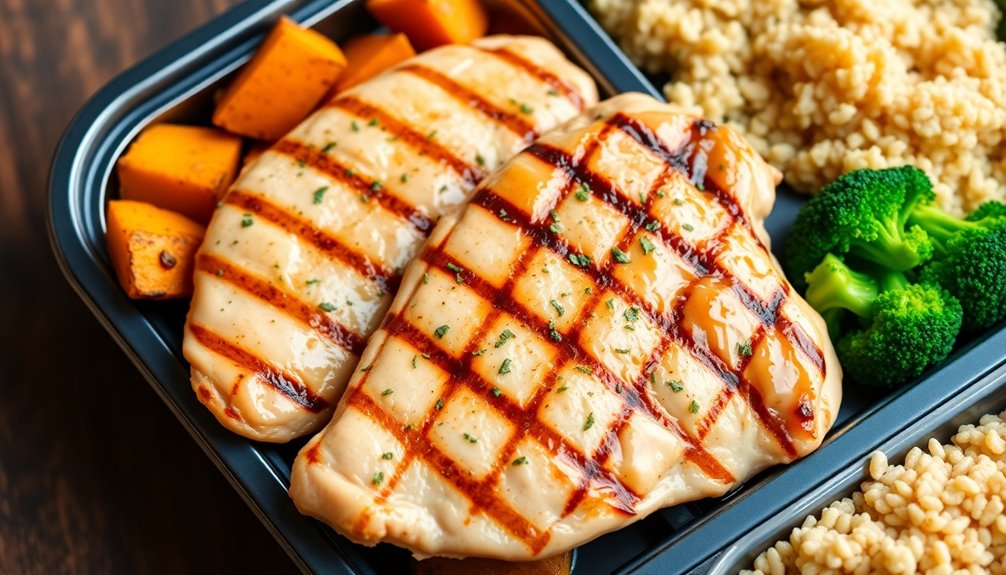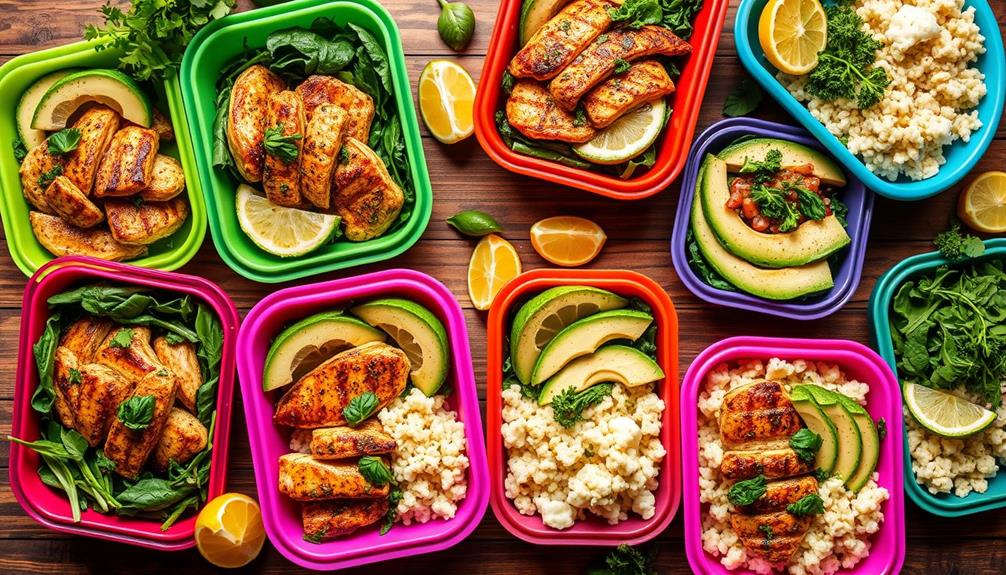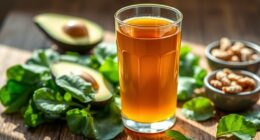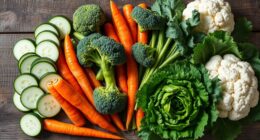For high-protein meal prep to boost muscle gain and aid recovery, focus on pairing gluten-free grains like quinoa or brown rice with lean proteins such as chicken, fish, or plant-based options like lentils and tofu. Incorporate nuts, seeds, and vegetables for added nutrients and flavor. Prepare these meals in advance and use portion-controlled containers to stay consistent. Keep exploring for more ideas to optimize your muscle-building meals effortlessly.
Key Takeaways
- Incorporate diverse plant-based and animal proteins like lentils, tofu, chicken, and fish for balanced muscle support.
- Prepare portion-controlled, high-protein meals in advance using gluten-free grains and nutrient-dense ingredients.
- Use flavor-enhancing herbs and spices to make meals appealing without added sodium or calories.
- Rotate different protein and grain combinations to maintain dietary variety and prevent boredom.
- Focus on nutrient-rich foods that promote muscle repair and recovery, such as quinoa, nuts, seeds, and green vegetables.

If you’re looking to build muscle, meal prep can be a game-changer. It allows you to control portion sizes, ensure you’re eating enough protein, and stay consistent with your nutrition goals. When it comes to high-protein meal prep ideas for muscle gain and recovery, incorporating plant-based options and gluten-free recipes can make your plan both diverse and inclusive. These choices not only support muscle growth but also cater to various dietary preferences and sensitivities.
Plant-based options are a fantastic way to add variety to your muscle-building diet. Think beyond traditional protein sources and explore lentils, chickpeas, black beans, and quinoa, which are packed with protein and fiber. You can prepare flavorful chickpea salads with roasted vegetables or cook up a batch of lentil stew for a filling, protein-rich meal. Tofu and tempeh are also versatile options that absorb flavors well, making them perfect for stir-fries or grain bowls. Incorporating a variety of these plant-based proteins helps you meet your daily protein needs while providing other essential nutrients. Plus, they tend to be easier to digest and are naturally gluten-free, aligning with gluten-free recipe requirements. For added flavor and nutrition, include nuts, seeds, and nutritional yeast, which boost protein content while adding texture and flavor.
When creating gluten-free recipes, focus on whole, unprocessed ingredients to avoid hidden gluten. Quinoa, amaranth, buckwheat, and millet serve as excellent gluten-free grains that can be cooked in advance and portioned out for the week. Combine these grains with lean protein sources like chicken, turkey, or fish, or with plant-based options such as tofu and beans. Preparing meals like grilled chicken with roasted sweet potatoes and sautéed greens, or a quinoa and black bean salad, ensures you get a balanced mix of carbs, protein, and healthy fats. Using herbs and spices to season your dishes keeps flavors vibrant without adding unnecessary calories or sodium.
Meal prepping these high-protein, gluten-free dishes in advance means you’ll always have nutritious options ready to go, minimizing the temptation to reach for less beneficial fast food. Keep your containers organized by portion sizes to track your intake effectively. Incorporate variety by rotating different plant-based options and gluten-free grains to prevent boredom and ensure you’re getting a wide range of nutrients. Whether you’re vegan, vegetarian, or simply looking to diversify your diet, these high-protein, gluten-free meals will fuel your muscles and support recovery, making your muscle-building journey more efficient and enjoyable.
Frequently Asked Questions
Can Plant-Based Proteins Support Muscle Gain Effectively?
You might wonder if plant-based proteins can support muscle gain effectively. The truth is, plant-based proteins can definitely promote muscle synthesis when you choose a variety of sources like beans, lentils, and tofu. They provide essential amino acids that help your muscles recover and grow. By combining different plant proteins, you’ll guarantee you’re getting enough nutrients to maximize muscle synthesis and support your fitness goals naturally.
How Often Should I Meal Prep for Optimal Recovery?
Imagine your body as a well-tuned engine needing regular refueling. You should plan your meal prep frequency like scheduled pit stops—every 3 to 4 days—to guarantee consistent nutrient intake. This approach helps with recovery optimization, preventing fatigue and muscle breakdown. By staying on this rhythm, you keep your energy levels steady and support muscle repair, making your gains more efficient and your workouts more effective.
Are There Specific Timing Strategies for High-Protein Intake?
You should focus on protein timing to optimize muscle recovery and growth. Aim to consume protein within 30 minutes to two hours after your workout, as this is when your muscles are most receptive. Spreading your intake evenly throughout the day supports nutrient timing, ensuring a steady supply of amino acids. Prioritize high-quality protein sources at each meal, and consider a protein-rich snack before bed to enhance recovery overnight.
What Are Quick, High-Protein Snacks for Post-Workout?
You might think quick, high-protein snacks are hard to find, but options like protein smoothies and Greek yogurt parfaits are perfect for post-workout recovery. They’re easy to prepare, portable, and packed with nutrients to fuel your muscles. Just blend your favorite protein powder with fruit and milk for a smoothie, or layer Greek yogurt with nuts and berries for a parfait. These snacks boost your recovery without taking much time.
How Can I Customize Meal Prep for Different Calorie Needs?
To customize your meal prep for different calorie needs, focus on meal portioning and calorie balancing. Adjust portion sizes based on your daily calorie target, increasing or decreasing carbs, fats, and proteins accordingly. Use measuring tools to guarantee accuracy, and consider adding nutrient-dense ingredients to meet specific goals. By carefully managing portions and balancing calories, you can tailor your meal prep to support your unique energy requirements.
Conclusion
Now that you’ve got these high-protein meal prep ideas, you’re all set to fuel your muscles and boost recovery. But here’s the thing—your progress depends on more than just what you eat. Consistency, timing, and pushing your limits matter just as much. Are you ready to take your muscle gains to the next level? The next step could be the game-changer you’ve been waiting for, so don’t hold back—your future gains are waiting.









